Zoom
Trash
Related: AI
- Environnement
- Not sure if good technology
- Plante
- Earth's Flora
- Peru_concytec
- Tech
- Miscellaneous
- Education
- Enterprise

Herbarium 2021 - Half-Earth Challenge - FGVC8. Reconstruction of damaged herbarium leaves using deep learning techniques for improving classification accuracy. SeedGerm: seeding success with machine learning and computer vision. Farmers need seeds that germinate effectively and uniformly within a given time frame in order to maximise efficiency.
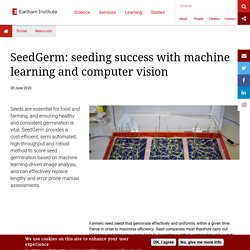
Seed companies must therefore carry out laborious and time-consuming tests to guarantee a certain germination rate is met. SeedGerm offers an easy-to-use, low-cost and scalable solution to this problem - and a handy application of machine learning. The product of a collaboration between the Earlham Institute (EI), the John Innes Centre (JIC), Syngenta and NIAB has today been published, open access, in New Phytologist, along with the open-source software and data.
Publication: A cabinet is equipped with cameras that take photographs throughout the germination process, documenting each stage from imbibition (seeds taking up water) through to the emergence of the root and further changes in the newly growing plant. Supervised machine learning is used to automatically determine how germination is progressing through comparing images. The variety of seeds is fascinating! And to show it, here you have the APGIV (2016) with selected #seeds. This is #plant #diversity at its best, in a structure so important for the plant and for us! □ You can download the full-size poster from my website. Data Beyond Vision. How do we represent tangible objects in a visual medium?

We use words, pictures, and diagrams. We describe, share, show, and fail. Humanists continue to expand the range of objects they study, but the range of scholarly outputs has not seen a similar expansion. While there are movements within Digital Humanities to consider nontraditional formats, the presentation and publishing of these experimental works (such as installations and project demos) are still secondary or sidelined, where they exist at all. What would it look like to consider non-textual research outputs as first-order scholarly work? Academic research has a long history of textual practice and citation that we haven’t yet figured out how to adapt to non-textual scholarship. The pieces that follow describe four different data physicalizations, which we consider to be one class of interpretive object. From a distance.Cold, commanding.Sense of mastery,but optical illusions deceive. Table of esters and their smells v2. Linking functional traits to multiscale statistics of leaf venation networks - Blonder -
Introduction Leaves have venation networks with architecture that varies widely, from a single vascular strand (e.g. pines) to purely branching structures (e.g.
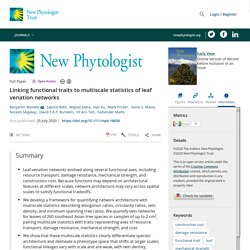
Ginkgo) to open net patterns (e.g. many ferns) to mostly parallel structures in monocots, to highly reticulate patterns in many angiosperms. Networks vary over multiple spatial scales, with several levels of branching at length scales from 10−5 m (the radius of a single vein) to 100 m (the length of some large leaves) (Roth‐Nebelsick et al., 2001; Sack & Scoffoni, 2013). We define spatial scale as a characteristic feature of the network with a certain extent, for example the area of a vein loop or the radius of a vein. Network architecture may be closely linked to multiple functions (Ronellenfitsch & Katifori, 2019). Review. Imaging flowers: a guide to current microscopy and tomography techniques to study flower development (J. Exp. Bot.) Flowers bear the reproductive organs and determine the reproductive success of plants by producing fruits and seeds.
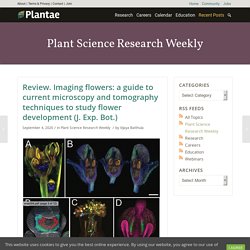
Flowers usually include four whorls of organs: sepals, petals, stamen and carpel. In this review, Prunet and Duncan discuss various microscopic and tomographic techniques to image flower organs with different levels of resolution and at different depths. They focus on the point-scanning confocal, spinning disc confocal and two-photon microscopy and their pros and cons, including the lateral and axial resolution, imaging depth, live imaging and fluorescent protein compatibility. Notebook Viewer. Applications in Plant Sciences. Over the past decade, advances in sensing devices and computer systems have allowed for the proliferation of high‐throughput plant phenotyping systems (Das Choudhury et al., 2019).
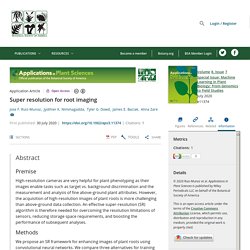
These systems are designed to acquire and analyze a large number of plant traits (Han et al., 2014; Krieger, 2014), including the measure of small structures, such as the venation network of leaves (Endler, 1998; Green et al., 2014). However, the characterization of plant roots is more challenging because they are “hidden” in the soil (Atkinson et al., 2019), which limits the type of sensors and techniques that can be applied.
A number of types of methods have previously been used to analyze root traits. Non‐imaging‐based in situ methods estimate the traits of the root system architecture (RSA) based on their correlations with chemical or physical properties. Other researchers have used destructive methods, in which the RSA is destroyed during or after the imaging process. Applications in Plant Sciences. Applications in Plant Sciences. The major challenge to understanding and cataloging plant diversity is devising novel approaches to speed up the process of discovery.
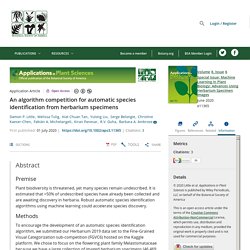
It has taken more than 250 years to name the 400,000 known plant species using a laborious manual process that relies on a shrinking group of experts examining individual specimens in detail. An estimated one million herbarium specimens remain unidentified, and as many as 70,000 flowering plant species alone are yet to be described (Joppa et al., 2011). It is very likely that new species are waiting to be discovered in the unidentified specimen backlog. Applications in Plant Sciences. Efforts to digitize herbarium specimens have expanded past transcribing textual content on labels and now often include broad‐scale specimen imaging.
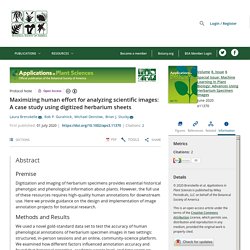
With the burgeoning growth of imaged historical plant specimen data and associated metadata, these data are poised to provide a crucial data resource about phenotypic and phenological traits (e.g., Yost et al., 2018; Lorieul et al., 2019; Park et al., 2019), extending over centuries of plant collecting effort. As of March 2020, iDigBio (Page et al., 2015; alone provides 19 million imaged plant specimens.
Despite the promise of these image resources, generating usable trait annotations from specimen images remains challenging, especially as the scale of data resources continues to grow. Symmetry at the Cellular Mesoscale. Applications in Plant Sciences. Software GinJinn was originally developed as an internal tool for rapid iteration through deep‐learning model architectures to find adequate neural network models for the detection and extraction of intact leaves in digital images of herbarium specimens for subsequent morphometric analyses.
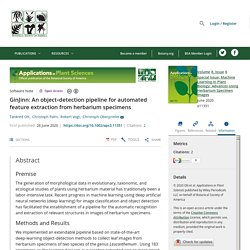
It has since evolved into a general object‐detection pipeline for the setup, training, evaluation, and deployment of bounding‐box‐based object‐detection models with a focus on providing easy access to a high number of different model architectures with little manual work for the user, including the automated download of pretrained models if available.
SeedGerm: seeding success with machine learning and computer vision. Composite modeling of leaf shape across shoots discriminates Vitis species better than individual leaves. Image analysis of phytoliths can tell grass species apart. Phylogeny, age and adaptive evolution of genus Allium. The genus Allium L., one of the largest monocotyledonous genera and one that includes many economically important crops with nutritional and medicinal value, has been the focus of classification or phylogeny studies for centuries.
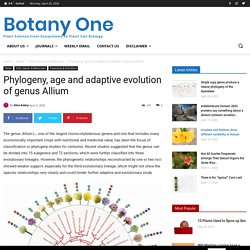
Recent studies suggested that the genus can be divided into 15 subgenera and 72 sections, which were further classified into three evolutionary lineages. However, the phylogenetic relationships reconstructed by one or two loci showed weaker support, especially for the third evolutionary lineage, which might not show the species relationships very clearly and could hinder further adaptive and evolutionary study. Their results detected a well-supported phylogenetic relationship of Allium. American Journal of Botany. Angiosperm leaves exhibit a dramatic diversity of sizes and shapes.
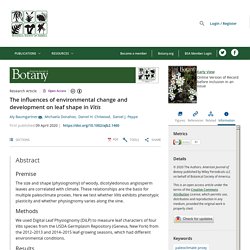
Leaf shape is dynamic and changes across many scales, from the evolutionary timescales that differentiate species (Bailey and Sinnott, 1915, 1916; Schmerler et al., 2012), to phenotypic plasticity during the lifetime of a single plant (Royer et al., 2008, 2009; Royer, 2012b; Chitwood et al., 2015, 2016; McKee et al., 2019), to heteroblasty at consecutive nodes as a plant grows (Jones, 1999), to the allometric changes in a single leaf as it develops (Nicotra et al., 2011). Herbarium 2020 - FGVC7. Applications in Plant Sciences. Notebook Viewer.
Leaves. Miscellaneous. Phenotyping. Plants in computer vision: Great Collection of Articles. Edited by: Dr Hannah Dee. Deep learning could discover new plant species hidden in centuries of herbarium data. Machine learning techniques excel at doing a good-enough job quickly in situations where there’s lots of data to grind through. It turns out that’s a great fit for backlogs of plant samples at herbariums and other repositories around the world, which have millions of the things waiting to be digitized and identified — including some that may be new to science.
There are thousands of such collections around the world housing some 350 million specimens like the ones shown. It’s suspected that hidden among them may be tens of thousands of new species — but the labor cost of manually going through all the samples to double-check them, modernize taxonomy and so on is prohibitive. Not only that, but the valuable info in these slowly vanishing temples to the plant kingdom needs to be modernized in order to be of use to an increasingly digital-first scientific community. Enter the deep learning system. Depending on what discipline you’re in, those results may sound either good or bad. Deep learning techniques differentiate bet plant families with 99% accuracy.
Computer vision applied to herbarium specimens: automated identification. Global Plants, a collaborative between JSTOR and some 300 herbaria, is now the world’s largest database of digitized plant specimens ( accessed 20 April 2016). It currently contains images of 2,482,901 million herbarium sheets (Hannah Begley, Digital Librarian for Primary Sources, JSTOR, 4 May 2016). Automated ID identification. AI Offering Fertile Ground for Biodiversity Informatics. How Moss Helped Machine Vision Overcome an Achilles’ Heel. In recent years, deep-learning algorithms have revolutionized the way machines recognize objects. State-of-the-art algorithms easily outperform humans in identifying ordinary things such as tables, chairs, cars, and even faces. But these algorithms have an Achilles’ heel: there are some things they just cannot see.
For example, machine vision is not good at recognizing things like grasses and herbs, because they have amorphous forms that are hard to define. A table generally has four legs and a flat surface, features that machine learning is good at identifying. By contrast, grasses and herbs of the same species can be different sizes and have different numbers of leaves, seeds, and so on, depending on the growing conditions.
Machines find it similarly hard to identify trees from aerial imagery or crops from satellite images. Methods for Automated Species Identification: book. Automated plant ID with noisy data. Massive Database of 182,000 Leaves Is Helping Predict Plant Family Trees. The story of a plant is etched in its leaves. A tree growing in a cold environment with plenty of water is more likely to have large leaves with many serrated teeth around the edges. But if the same species lives in a warm, dry region, its leaves are likely to be smaller and smoother. Now, an atlas that traces the shapes of 182,000 leaves from 141 plant families and 75 locations around the world shows promise for refining scientists’ ability to read that story.
Using that atlas, researchers found that leaf shape alone accurately predicted where a leaf was collected 14.5% of the time, and plant family correctly 27.3% of the time. That is far better than predictions made using conventional methods to describe a leaf's shape. Automated Plant Species Identification: Challenges and Opportunities. Semantic Segmentation of Herbarium Specimens Using Deep Learning Techniques. Work on a Single Leaf: Topological Data Analysis. Training Machine Learning: Sample Specimen Dataset.